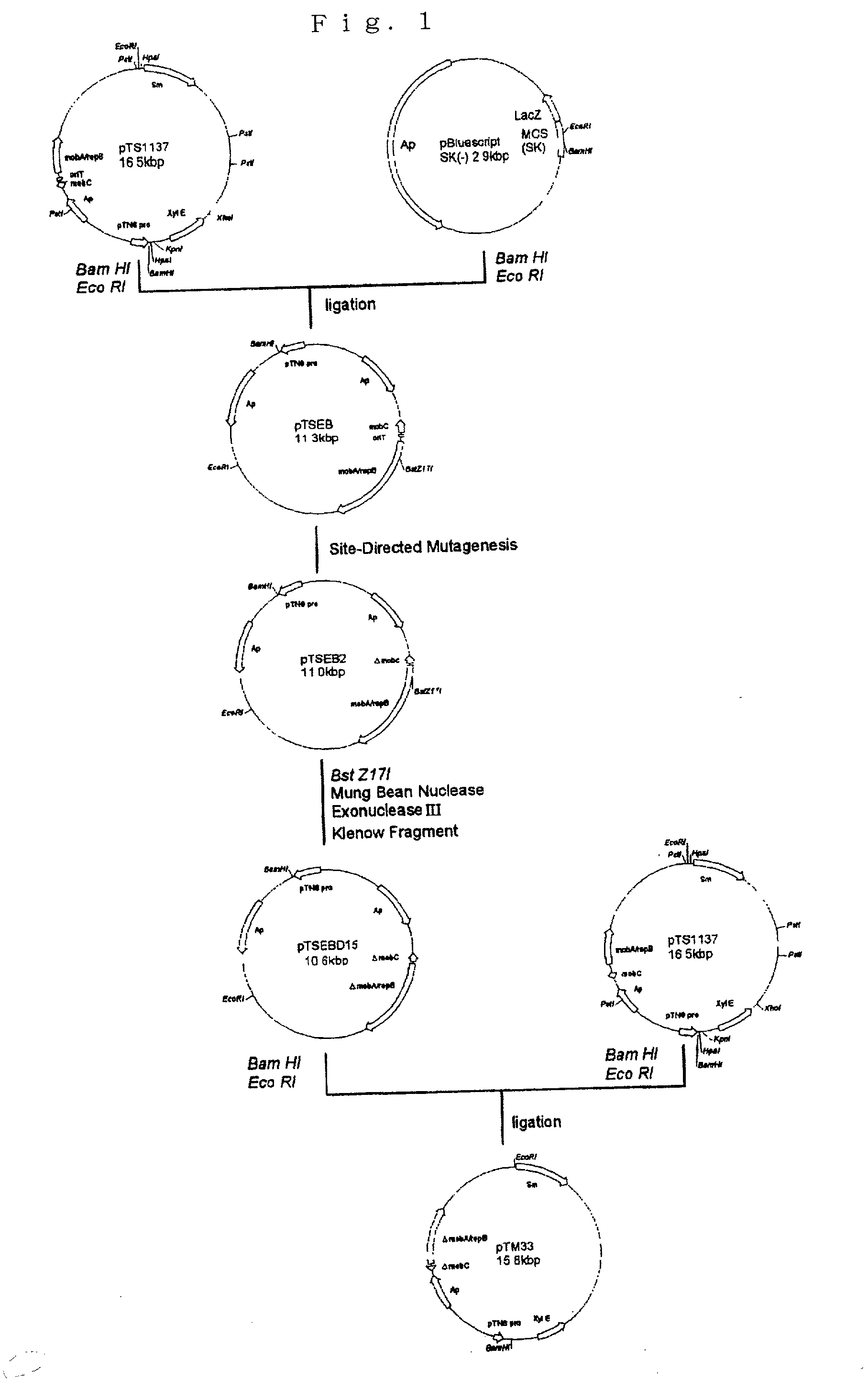Novel plasmid, bearing the plasmid, and method of producing an enzyme using the transformant
a technology of plasmids and transformants, which is applied in the field of new plasmids, bearing plasmids, and producing enzymes using transformants, can solve the problems of large amount of expensive pqq, small amount of expression, and high cost of pqq, and achieve the effect of safe production
- Summary
- Abstract
- Description
- Claims
- Application Information
AI Technical Summary
Benefits of technology
Problems solved by technology
Method used
Image
Examples
example 1
[0058] Construction of a Vector Deprived of Conjugative Transfer Function
[0059] The broad-host-range vector pTS1137 fragment containing the conjugative transfer gene group mob as cleaved with BamHI and EcoRI was ligated to pBluescript SK(-) as cleaved with the same restriction enzymes to give pTSEB.
[0060] Then, mutation primers having the nucleotide sequences shown under SEQ ID NO:1 (sense strand) and SEQ ID NO:2 (antisense strand) were constructed.
[0061] Using the above primers and Transformer Site-Directed Mutagenesis Kit (CLONTECH), a 258 bp fragment containing mobC and oriT was eliminated to give pTSEB2. This pTSEB2 was further cleaved with BstZ17I, digested with Mung Bean Nuclease, Exonuclease III, and repaired with Klenow fragment to give pTSEB15. The pTSEB15 was cleaved with BamHI and EcoRI and ligated to pTS1137 as similarly cleaved with BamHI and EcoRI to give pTM33 (FIG. 1).
example 2
[0062] Evaluation of Conjugative Transfer Function
[0063] The conjugative transfer function of the vector constructed in Example 1 was evaluated by the following method.
[0064] The pTM33-transformed Escherichia coli JM109, E. coli C600 (RK2) and E. coli XL2-Blue MRF' were inoculated into LB liquid medium containing 100 .mu.g / ml of streptomycin, LB liquid medium containing 10 .mu.g / ml of kanamycin, and LB liquid medium containing 20 .mu.g / ml of chloramphenicol and shake-cultured at 30.degree. C., 37.degree. C. and 37.degree. C., respectively, until the OD660 value had reached 1 to 2.
[0065] The above cultures, 1 ml each, were admixed and the cells were collected on a sterilized nitrocellulose filter (pore size 0.45 .mu.m). This filter was placed on antibiotic-free LB agar and incubated at 33.degree. C. for 4 hours. Then, the cells on the filter were diluted with 2 ml of sterilized saline, streaked on LB agar containing chloramphenicol (Cam; 20 .mu.g / ml) and LB agar containing chloramphe...
example 3
[0067] Construction of an Expression Vector for a Glucose Dehydrogenase Taking PQQ as the Prosthetic Group
[0068] From the vector pGLD5 harboring a PQQ-dependent glucose dehydrogenase gene derived from Acinetobacter calcoaseticus NCIMB11517, the GDH gene fragment was excised with BamHI and XhoI and ligated between the BamHI and XhoI sites of the pTM33 constructed in Example 1 to give pGLD6.
PUM
 Login to View More
Login to View More Abstract
Description
Claims
Application Information
 Login to View More
Login to View More - R&D
- Intellectual Property
- Life Sciences
- Materials
- Tech Scout
- Unparalleled Data Quality
- Higher Quality Content
- 60% Fewer Hallucinations
Browse by: Latest US Patents, China's latest patents, Technical Efficacy Thesaurus, Application Domain, Technology Topic, Popular Technical Reports.
© 2025 PatSnap. All rights reserved.Legal|Privacy policy|Modern Slavery Act Transparency Statement|Sitemap|About US| Contact US: help@patsnap.com

